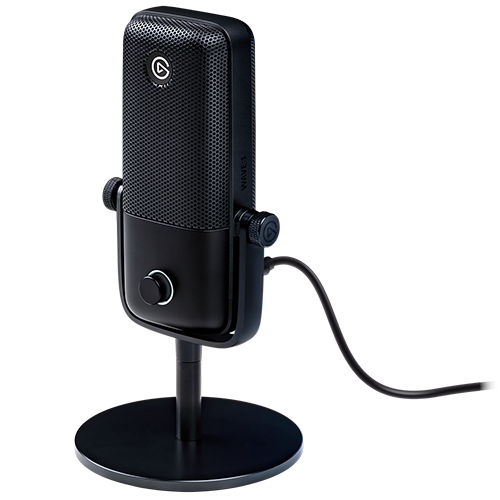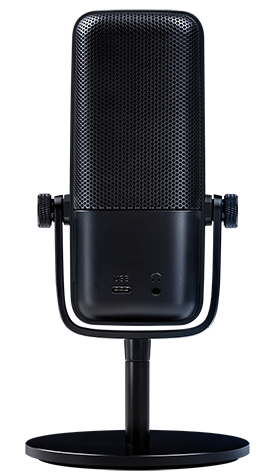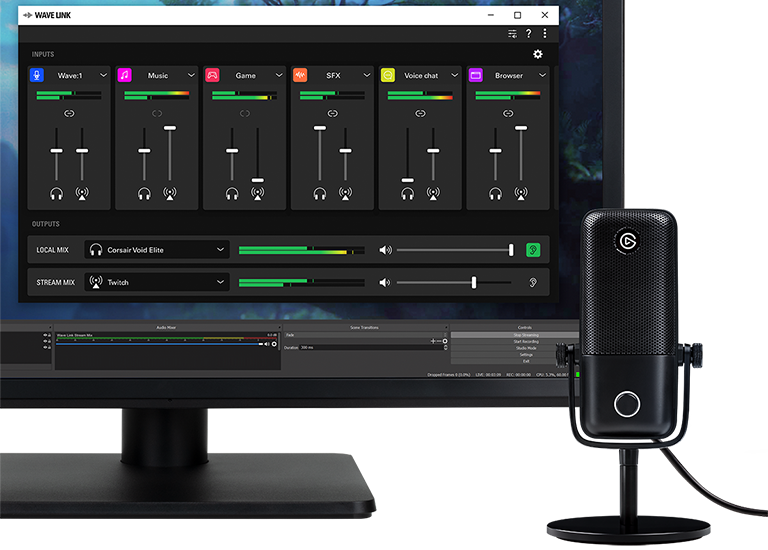Elgato has established itself as a go-to brand for content creators and streamers wanting to up their game, and following a 2018 acquisition by Corsair, there has been a concerted effort to expand the firm's product range.
The latest capture cards and Stream Deck programmable hotkey pads have been well-received, and after plenty of teasing in recent months, Elgato is extending reach with the launch of its first premium microphone and digital mixing solutions, the Wave:1 and Wave:3.
Priced at £130 and £160, respectively, the mics claim to have been "built from the ground up for creators," and we've been able to go hands-on with the base model. First impressions are certainly favourable as the sleek black exterior and classic design are very easy on the eye. An important point as Elgato's target audience is keen to be seen, and Wave:1, measuring 200mm tall, is an attractive addition to a studio environment. Solid build quality is reflected in a 555g weight, and a large rubberised pad beneath the 100mm base helps keep the unit firmly planted. If you prefer, the stand is easily detached for mounting the mic on a boom arm using the supplied adapter.
Capable Hardware
It looks and feels like a serious piece of kit, and there's high hope for Wave's acoustic credentials as Elgato partnered with sound engineers from Austrian microphone specialist Lewitt throughout the design process. The collaboration results in a 17mm cardioid condenser capsule whose thin diaphragm promises superior frequency and transient response that is ideally suited to speech.
Wave's technical specifications tout 24-bit resolution, sensitivity ranging from -25dBFS (min gain) to 15dBFS (max gain), and frequency response in the 70-20,000Hz range. Sample rate is one area in which the two launch models differ, with Wave:1 limited to 48kHz while Wave:3 increases accuracy through a superior sampling rate of 96kHz.
Both models include an internal pop filter, a switchable low-cut filter to minimise boom by eliminating frequencies under 80Hz, and protection against clipping through proprietary Clipguard technology integrated into the analogue-to-digital converter. When overdriven, Clipguard can automatically switch to a second audio channel operating at lower volume to guard against distortion, as evidenced by the max SPL climbing from 120dB to 140dB with Clipguard engaged.
The goal is to give creators balanced input without the need to constantly tweak levels, and that is reflected in a single backlit dial that glows red when pushed to mute or increases brightness when turned to adjust output volume. Wave:3 is more sophisticated in this regard and includes a series of status LEDs that combine with the solitary dial to also control gain and crossfade. Both variants offer identical connectivity, with the back of the microphone home to a USB-C connector (a Type-C to Type-A cable is included in the box) and a 3.5mm headphone jack.
Elgato's hardware serves as a capable choice for those taking their first steps toward a dedicated standalone mic. To my admittedly untrained ear the Wave:1 is superior to any ordinary mic I've ever used, with crisp, clear and well-defined vocals at the recommended recording distance of roughly 20cm. There are a couple of caveats, mind. Wave:1's cardioid pattern isn't adjustable, limiting versatility if you're planning multi-user sessions, and the mic's high sensitivity picks up a fair amount of background noise. Reducing gain helps somewhat, but Elgato expects further refinement through the accompanying software, which is a key selling point of the Wave proposition.
Software Enhancement
The suite, dubbed Wave Link, is available for Windows 10 or MacOS (10.14 or newer) and gives users the means to create and monitor two independent output mixes; making it easy to control what you and your audience will hear. On-the-fly switching between the two is just a click away, and at launch, Wave Link offers the ability to mix eight channels of your choice, providing fine-grained control over, say, game audio, music and Twitch content.
A clutter-free interface makes the software reasonably intuitive to use. Firmware updates are seamless, there are options to independently disable low-cut filter and Clipguard, and for advanced users, Wave Link can be set as a master audio source in OBS Studio. Do note, however, that routing audio to the specific Wave Link channels - music, game, etc. - is handled by the OS, so you will find yourself spending a bit of time in Windows' Sound Settings, setting the relevant apps to output to the corresponding channel.
What's clear is that Elgato sees this first iteration of Wave Link as a foundation on which to build. We're told the software "will evolve to incorporate community feedback," and the Wave ecosystem as a whole is expected to develop over time. The list of optional accessories already includes a shock mount (£40) and external pop filter (£30), and in the past week, Wave Link has been fully integrated with Stream Deck, putting a comprehensive range of actions such as mute, volume and gain adjustment within touching distance, taking away the need to handle the mic and create inadvertent noise. Looking ahead, we're told that audio filters to aid noise suppression and noise reduction will be coming to Wave Link in the near future. As a hardware-plus-software solution, expect Wave microphones to improve over time.
Elgato Wave is not yet expected to rival pro condenser mics, but it is the combination of capable hardware and maturing software that makes it an intriguing proposition for content creators and streamers alike. At £130, Wave:1 represents a safe starting point for users seeking a one-stop solution for both high-quality recording and digital mixing.

The Good |
The Bad |
|
Sleek design High-quality condenser mic Wave Link makes light work of mixes USB-C and headphone jack with volume control Stream Deck integration |
Sensitive to background noise Supplied stand not the most versatile |

Elgato Wave:1
HEXUS.where2buy
TBC.
HEXUS.right2reply
At HEXUS, we invite the companies whose products we test to comment on our articles. If any company representatives for the products reviewed choose to respond, we'll publish their commentary here verbatim.










